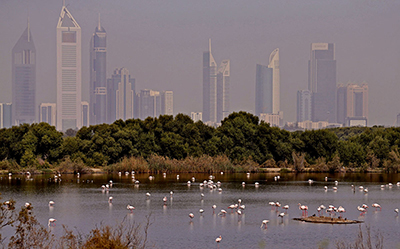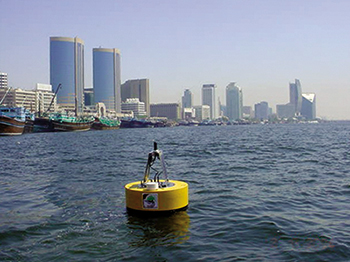Dubai Continuous Water Quality Instruments
Dubai Municipality, Dubai, United Arab Emirates, utilizes a YSI water quality monitoring buoy at a sensitive area within the Dubai Creek.
Dubai Creek is a saltwater creek located in Dubai, United Arab Emirates (UAE). It ends at Ras Al Khor Wildlife Sanctuary. Some sources say that the creek extended as far inland as Al Ain, and that the Ancient Greeks called it River Zara.
Historically, the creek divided the city into two main sections – Deira and Bur Dubai. It was along the Bur Dubai creek area that members of the Bani Yas tribe first settled in the 19th century, establishing the Al Maktoum dynasty in the city. In the early 20th century, the creek, though incapable then of supporting large-scale transportation, served as a minor port for dhows coming as far away as India or East Africa. Although it impeded the entry of ships due to current flow, the creek remained an important element in establishing the commercial position of Dubai, being the only port or harbor in the city. Dubai's pearling industry, which formed the main sector of the city's economy, was based primarily on expeditions in the creek, prior to the invention of cultured pearls in the 1930s. [Source: Wikipedia]

Pink flamingos are pictured in the water at the Ras al-Khor Wildlife Sanctuary on the outskirts of Dubai in the United Arab Emirates on March 26, 2015. (KARIM SAHIB/AFP/Getty Images)
Redha Hassan Salman, Head of the Environment Protection and Safety Section of the Municipality’s Environment Department, is responsible for the system and says that “the buoy is located toward the end of the creek, close to Jaddaf and the Ras Al Khor Sanctuary. This location was chosen because of the many ongoing projects in nearby areas, the proximity of the sanctuary, and the potential environmental threat presented by drainage water released into the creek nearby.”
Importance of the Site
The Ras Al Khor Sanctuary is particularly important because it hosts some 67 species of birds, nine of which occur in internationally important numbers, in that they represent greater than one percent of the world’s population for those species. The project’s objective is the automation of marine water quality monitoring in the creeks and coastal environments.
Describing the monitoring system, Redha Hassan Salman reveals “The entire process of water quality real-time monitoring is carried out through an Environmental Monitoring Module, which consists of a buoy, multiparameter water quality sensor probes, Data Acquisition System, Cellular mobile connection, solar panel and software running on a base station computer located at the main building of Dubai Municipality.”
The buoy is moored to a heavy anchor and is able to take readings from a YSI multiparameter sonde (such as an EXO1 or EXO2) fitted with sensors for temperature, pH, salinity, dissolved oxygen concentration, and chlorophyll. Chlorophyll is the pigment that allows plants—including algae—to convert sunlight into organic compounds in the process of photosynthesis.
Chlorophyll a is the predominant type found in algae and cyanobacteria (blue-green algae), and its abundance is a good indicator of the amount of algae present in water. YSI manufactures a highly accurate total algae sensor (for freshwater or saltwater) for the EXO sondes.
Excessive quantities of chlorophyll can indicate the presence of algae blooms. These usually consist of a single species of algae, typically a species undesirable for fish and other predators to consume. Unconsumed algae decay, using up the oxygen required by other organisms to survive. The presence of too many nutrients, such as nitrogen and phosphorus, can stimulate algal blooms and result in reduced water quality and clarity. Algal blooms can also limit light penetration and thereby damage ecosystems in shallow water.
Real-time data for pH, temperature, salinity, and dissolved oxygen will quickly reveal any incidents of point source pollution, and algae measurements will reveal any trends that may take place as a result of diffuse or longer-term pollution.
The base station computer at Dubai Municipality is connected to a modem that periodically dials up the cell phone modem on the buoy in order to download the data that has been collected. Mr. Salman believes that real-time data is essential “in order to understand the changes in water quality chemistry,” adding “the entire monitoring process is automatic and just needs periodic maintenance for calibration and cleaning the equipment”
The buoy-mounted equipment in Dubai Creek is one example of YSI System’s ability to build a system to precisely match the needs of both the customer and the application.

Additional Blog Posts of Interest
Impaired Ecosystem Monitoring in Mount Hope Bay
Estuary Research Project Highlights Advantages of Continuous Monitoring
Extend Your Water Quality Sonde Deployment Times with Wiped Sensors [Case Study]
The Evolution of Water Quality Monitoring [Free eBook]